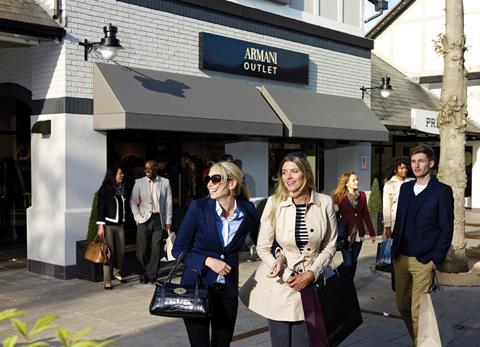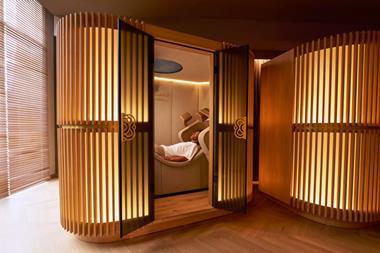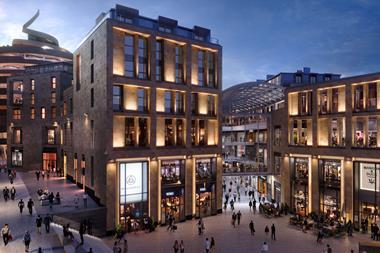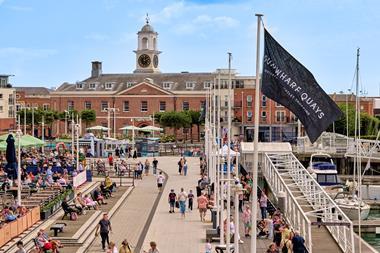Two new designer outlets are being built in the UK, with London Designer Outlet opening at Wembley this year. But will there be more? And how can retailers choose the right schemes?

While the biggest and the best in the designer outlet sector are thriving, the picture is far from consistent in a retail category that encompasses everything from luxury shopping to factory shops in far-flung locations. It would seem that, despite the upcoming addition of at least two new centres in the UK, the future may be about less rather than more.
For now the focus is on the most immediate additions, London Designer Outlet in Wembley and the Resorts World outlet, adjacent to the NEC in Birmingham. The former will open later this year. It is immediately across from the national stadium and Wembley Arena and - in a significant nod to the trend of the moment - includes a high level of food and beverage offers, and a cinema. The NEC project is even more multi-purpose, featuring a casino, conference centre, a four-star hotel and 11-screen cinema alongside 60 retail, food and beverage units.
It will open in spring 2015.
Colin Brooks, managing director of asset management firm Realm, is working on both projects. He says the recession helped bolster designer outlets. “But that is no reason to sit back,” he cautions. “As an offer that sits somewhere between retail and leisure, it is unique. I feel people generally go to an outlet centre with a mindset to spend money they have allocated to the day, and we need to respond to market changes.”
Ken Gunn, director of outlet specialist FSP, thinks the UK designer outlet market has almost reached saturation and has settled into a similar model to the rest of Europe. The best-known operators, Value Retail - owner of Bicester Village - and McArthurGlen, represent the luxury and upscale centres, followed by a host of mid-scale centres by size and proposition. Smaller centres in less affluent catchments have struggled, says Gunn. “We have seen the closure of Freeport Scotland and Whiteley Village [which is being relaunched in May as a shopping centre], and K Village in Kendal in administration, while Rathdowney Shopping Outlet in Ireland has also closed,” he says. “The scale and the quality of line-up are dictating occupier demand and emphasising the need for centres to provide a complete package for visitors.”
Constrained opportunities
McArthurGlen Northern Europe managing director Henrik Madsen believes the UK is quite saturated. “There are a lot of good schemes in the UK but also a number that have not fulfilled their potential,” he says. “Is there space for more? Perhaps one in the Midlands and one in the South - but the opportunities are constrained not only by consumer demand but by brand demand.”
The pressure is on. As with the mainstream shopping centres, retailers are voting with their feet and deserting any scheme they believe to be underperforming. Gunn says on top of that, while plenty of retailers and brands do have an outlet strategy, few operate these on a large scale certainly compared with the US. “While outlets have gradually found a wider range of retailers to choose from, the number of retailers with more than, say, 10 stores is quite small and the brand strategies vary,” he says.
In such a niche sector, outlets are competing for retailers against European counterparts. Cushman & Wakefield retail partner Mark Burlton says: “For smaller schemes, what you have to consider is that brands are not simply choosing whether to open another outlet store in the UK. If you already have a number in the UK, why open on a secondary scheme when you could open on a prime scheme just outside Paris, or in Germany?”
Such challenges mean the UK outlet sector may well consolidate, rather than expand. “Depending on your definition of an outlet, there are perhaps 45 in the UK and it would not be inconceivable for 20 of those to no longer be around in years to come. It’s also difficult to see new sites being built,” warns Andy Rich, director of outlet malls at investment firm Henderson.
That said, the fortunes of the better centres remain in sharp contrast to mainstream retail. Henderson is one of the few major funds to have a strong position in outlet centres. It operates a UK portfolio that has “continued to provide double-digit growth over the past two years”, says Rich. He believes the key to future performance is the shift towards luxury and premium, which requires investment and improvement. “We have been repositioning Cheshire Oaks and as part of that we replaced the food court with a new catering offer, which provided the space to bring in Marks & Spencer and some luxury brands including Armani, Lulu Guinness and Burberry,” he says. “But you can’t do that everywhere. Cheshire Oaks is on the tourist trail and also benefits from the large Chinese population in nearby Manchester [who often do a lot of luxury discount shopping].”
Need for flexibility
If luxury and premium positioning is not possible then flexibility is the key for outlet centres. Many need to reinvent themselves and provide a locally tailored offer that might help woo retailers outside the outlet sector, says Brooks. “Polarisation is certainly affecting investment, and for smaller schemes it is all about considering positioning and being flexible. Smaller locations might only have a catchment of 15 to 20 minutes, so then it’s about looking at the local needs and understanding the neighbourhood,” he says.
Smaller locations need a convenience-led approach - the Freeport Talke outlet in Stoke would be a good example, where Home Bargains has just signed. “That is not a typical outlet store but it is a great footfall driver Monday to Friday,” says Brooks. “With these smaller schemes you have to be fluid with your thinking and move with the times.”
Henderson asset manager Jamie Acheson agrees: “Bridgend [another Henderson scheme] is a different type of proposition. It acts as a town centre but we have replaced the food offer with a sit-down offer and brought in a cinema. Brands such as Tommy Hilfiger, Kurt Geiger and Timberland represent aspiration for a location like Bridgend and we’ve also been able to add space to the scheme.”
Food and beverage is a crucial battleground, says Madsen, while ramping up customer services is also necessary. “The food and beverage offer has become more important and we have been adding to our provision, but I think it is also about redefining our priorities about a day out,” he says. “We are working hard to deliver on treating our customers as guests.”
Brooks says the catering offer at outlets has been quite poor until recently. “We have been adding the likes of Prezzo, Frankie & Benny’s and Pret A Manger to improve that,” he says. “You can see that approach at London Designer Outlet.”
New designer outlet developments are unlikely but the Wembley and NEC projects signal the way forward for designer locations.
Where next for the UK outlet sector?
The consensus among investors and developers suggests that the UK - Europe’s oldest designer outlet market and, along with Italy, the continent’s biggest - has reached saturation. Perceived gaps in the Midlands and around London will be filled by Resorts World and London Designer Outlet respectively.
“There still looks to be an opportunity between the M3 and M23 and the more affluent elements of the Southwest corridor. Birmingham had been lacking provision but the NEC scheme should cover that,” says FSP director Ken Gunn.
Henderson director of outlet malls Andy Rich says: “You could make an argument for the Southwest but the catchment would probably not support it. Similarly, the Northeast does not have a centre but the cities are not really large enough to support a major outlet centre.”
Realm managing director Colin Brooks says: “You could perhaps look to a scheme in East Anglia near Norwich but you would have to be very confident about its prospects. The fact that investors have not put forward new schemes suggests there is not that confidence.”
The premium option: Bicester Village

“For a premium centre such as Bicester Village our objective has been to create an amazing experience and to make it worth travelling for. We have a global consumer, many of whom travel from London or other parts of the UK,” says Bicester Village business director Sylvie Freund-Pickavance. About 65% of spend is from outside the UK, and the aim is to provide more than just a luxury experience - unique brands are offered. “We have done
a lot of work to bring in the best of British and as part of that we are working with the British Designers Collective again this year,” she explains.
Freund-Pickavance says shoppers come for a day out, meaning the catering proposition has to be strong. “The food offer has been enhanced to recognise that and in line with changing customer demands,” she says. Of course, shopping is the primary purpose, so it is about providing something nice but also quite quick and we have developed our outside areas too.
“Whether we would ever repeat Bicester Village elsewhere in the UK would be a decision for the brands. We would only look at it if there was the appetite from them.”
New in the capital: London Designer Outlet

London Designer Outlet (LDO) is due to open this autumn, and property development and investment firm Quintain is in the final phase of the leasing programme. LK Bennett, Max Studio, Guess and Superdry are some of the latest leasings. At the end of last year, LDO was 52% (by year one base rent) exchanged or in solicitors’ hands. Anchor retailers include Nike, Gap, Clarks and Marks & Spencer, while restaurants include Prezzo, Handmade Burger Co and TGI Friday’s.
The 350,000 sq ft centre will include a nine-screen Cineworld. LDO is adjacent to Wembley Stadium, Wembley Arena and a four-star Hilton hotel, which opened last July.
Extension at Swindon

Swindon Designer Outlet is to be extended with more than 50,000 sq ft of retail and catering space. The £35m development involves the regeneration of the historic Long Shop, built in 1874 as part of the Grade II-listed Great Western Railway Works, which will become part of the centre. The Long Shop, opposite Steam - Museum of the Great Western Railway, will house up to 30 new retail units, while the development includes an external quarter and restaurant offering.
The 207,000 sq ft Swindon Designer Outlet, home to more than 90 brands including Hugo Boss, Jaeger, LK Bennett, Next, Superdry, Ted Baker and Tommy Hilfiger, was developed by McArthurGlen and opened in 1997.
“In Swindon, we are trying to build critical mass, with new food and beverage and extra retail,” says Henderson director of outlet malls Andy Rich. “We are aware that at its current size it perhaps does not have the pull to attract affluent Oxford shoppers. Bicester has a great luxury offer but Swindon has the potential to be a very strong local centre.”
New for Birmingham: Resorts World, NEC

Leisure and casino operator Genting UK appointed Realm to provide asset management and leasing on the £150m integrated leisure complex, Resorts World Birmingham, which adjoins the NEC.
Construction of the 538,000 sq ft leisure and entertainment complex began in February and will last two years.
Opening in spring 2015, it will include 60 retail, food and beverage units, an 11-screen cinema, a four-star hotel with pool, gym and 10 five-star VIP suites, a multi-use banqueting and conference centre and a casino.
Resorts World is part of the NEC’s wider strategy to offer visitors a more diverse leisure and hospitality experience.


























No comments yet